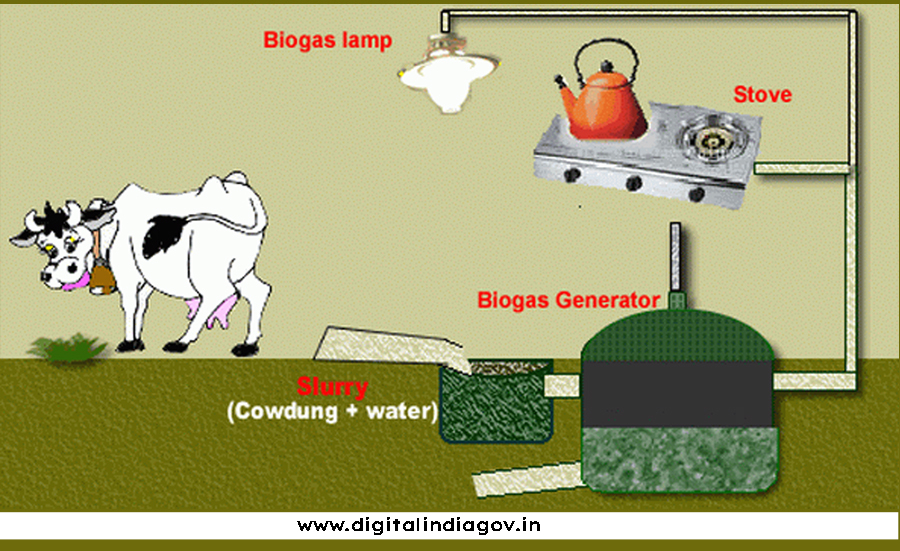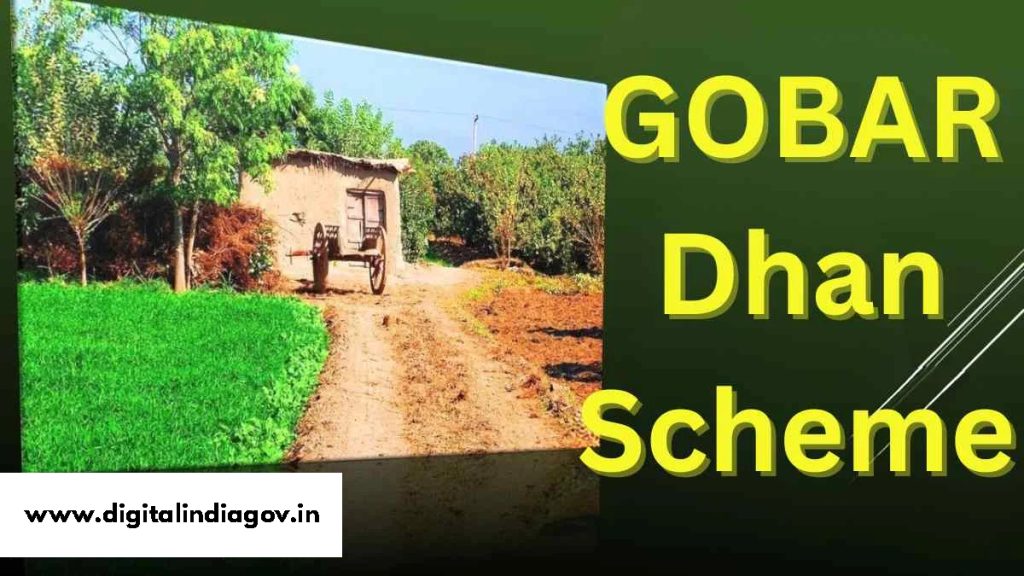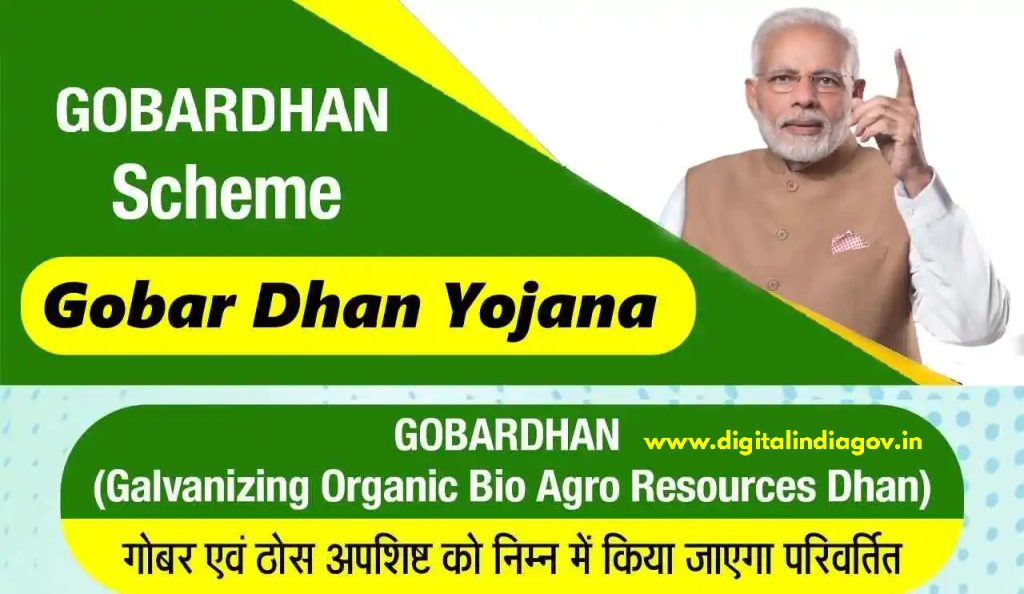GOBARDhan Scheme:- Under the Swachh Bharat Mission Gramin’s second phase, the Government of India’s GOBAR-Dhan Scheme, which was established in 2018, has been designated as a national priority effort. The Union Budget 2023 featured a statement from the Finance Minister regarding the creation of 500 new ‘waste to wealth’ facilities as part of the GOBAR-Dhan initiative. With a Rs 10,000 crore investment, this action seeks to promote a circular economy. Compressed biogas plants (CBG) will make up the remaining 300 new plants, of which 75 will be located in urban areas. The remaining 200 will be community- or cluster-based.
Contents
Gobar Dhan Scheme Highlights
| Name of the scheme ✅ | GOBARDhan Scheme |
| Who started | Arun Jaitley ji |
| Launch Date | 1 February 2018 |
| Sponsored by | Central. Govt |
| Scheme beneficiary | Farmer |
| Objective of the plan | doubling farmers’ income |
| Official website | Click Here |
| Registration year | 2024 |
| Application mode | Online |
| Department | MINISTRY OF JAL SHAKTI |
| User Manual | Download |
Exploring the GOBARDhan Scheme (Galvanising Organic Bio-Agro Resources)
The Department of Drinking Water and Sanitation, under the Jal Shakti Ministry, inaugurated the GOBAR-Dhan project in April 2018. The major objectives of the program are to keep villages clean, increase the income of rural people, and produce electricity from cattle manure.
- The Swachh Bharat Mission (Gramin), which aims to establish open defecation-free (ODF) communities and manage solid and liquid waste in rural regions, has the GOBAR-Dhan plan as a crucial component.
- The goal of the GOBHAR-Dhan Unified Portal is to make it easier to implement biogas schemes and projects smoothly and to track them in real-time.
- Under the GOBAR-Dhan program, 589 biogas/CBG (compressed biogas) units are now running. There are also 251 plants in construction.
- 168 districts have implemented the program thus far.

Also Read:- Swadhar Yojana
Background on the GOBARDhan Scheme
In order to improve village cleanliness and produce income and energy from animal and organic waste, the Indian government introduced GOBARDHAN in April 2018 as a part of the Swachh Bharat Mission (Grameen) Solid and Liquid Waste Management component. Since rural India has already achieved Open Defecation Free (ODF) status, GOBARDHAN has become even more crucial as it helps the villages reach ODF-plus status, a crucial goal of Swachh Bharat Mission (Grameen) Phase II.
Objectives of the GOBARDhan Scheme
- The program’s goal is to help villages safely dispose of agricultural waste, cow dung, and eventually all organic waste.
- Through decentralized systems, it helps communities turn their organic waste and cattle into wealth.
- The program effectively disposes of waste in rural regions, which helps to reduce vector-borne diseases.
- It encourages the production of biogas and fertilizer for use in rural regions from organic waste, particularly animal manure.
- The program provides chances for jobs and revenue generation while promoting rural entrepreneurship.
Implementing the GOBARDhan Scheme
Four models are used to accomplish the strategy. In accordance with the GOBAR-DHAN principles, each model has the following incentive:
- Model-A (Gramme Panchayat): Depending on the number of homes in the Gramme Panchayat, the incentive ranges from Rs. 7 lakh to Rs. 20.00 lakh.
- Model-B (SHG Federation): Model-A and Model-B share a similar incentive structure.
- The incentive structure for Model-C (Bulk Waste Generator/Entrepreneur) is the same as that of Model-A.
- Model-D (Any Eligible Enterprise): This model does not offer any incentives.
Stakeholders in the GOBARDhan Scheme
- Dept of Agricultural Research and Education
- Dept of Agriculture, Cooperation and Farmers’ Welfare
- Dept of Rural Development
- Ministry of New and Renewable Energy
- Ministry of Skill Development and Entrepreneurship
- Dept of Drinking Water and Sanitation
- Ministry of Petroleum and Natural Gas
- Dept of Animal Husbandry and Dairying
- Ministry of Environment, Forest and Climate Change
- Dept of Science and Technology
- Dept of Fertilizers
Understanding Biogas
Biogas has a variety of applications. 35–44% carbon dioxide, 55–65% methane, and trace amounts of nitrogen, sulfur dioxide, and ammonia make up its majority composition.
- Similar to LPG, biogas can be utilized as a clean cooking fuel for motive power, illumination, and energy production when left unprocessed.
- Biogas is a green fuel that may be refined to a 98% purity level and used for transportation or filling cylinders. This technique is known as compressed biogas (CBG) since it requires a high pressure of about 250 bar.

Also Read:- Agneepath Scheme Apply
Benefits of the GOBARDhan Scheme
Swachh Bharat Mission – Gramin 2.0 :
In order to achieve safe management of animal and biodegradable waste, Swachh Bharat Mission – Gramin 2.0 offers financial support of up to Rs. 50 lakh per district for the establishment of at least one model community biogas plant at the village, block, or district level. To view additional information, go here.
Sustainable Alternative Towards Affordable Transportation (SATAT)
The Compressed Bio Gas (CBG) scheme, part of the Sustainable Alternative Towards Affordable Transportation (SATAT) initiative, incentivizes entrepreneurs to establish CBG plants and deliver CBG to Oil Marketing Companies (OMCs) for sale as industrial and automotive fuels. Click here for further information.
Swachh Bharat Mission – Urban 2.0:
In accordance with the plan guidelines, the Ministry of Housing and Urban Affairs offers States and Union Territories additional Central Assistance for solid waste management under the Swachh Bharat Mission Urban 2.0 scheme. For MSW-based CBG facilities, further central assistance of 25%, 33%, 50%, or more (depending on ULB population) is available; the maximum cost per 100 TPD is Rs. 18 crore. For additional information, go here.
Waste to Energy Programme:
The Waste to Energy Program’s goal is to assist in the establishment of waste-to-energy projects that use agricultural, industrial, and municipal wastes and residues to produce biogas, bioCNG, power, producer gas, and syngas. Project developers can receive Central Financial Assistance (CFA) from the program, and implementing/inspection agencies can charge service fees for the successful commissioning of Waste to Energy plants that generate biogas, bio-CNG, compressed or enriched biogas, power, or producer or syngas. For additional information, go here.
Animal Husbandry Infrastructure Fund:
A central sector programme totaling Rs. 15,000 crore is known as the Animal Husbandry Infrastructure Development Fund (AHIDF). Based on the submission of workable projects by qualified beneficiaries, the project under the AHIDF is eligible for a loan from the Scheduled Banks for up to 90% of the estimated/actual project cost. A 3% interest subvention will be given to all eligible entities under the AHIDF. In April 2022, the Animal Waste to Wealth Management (including Agri waste management) component of the AHIDF included the manufacture of Bio-CNG and Phosphate Rich Organic Manure (PROM) as eligible activities. For additional information, go here.
Agri-Infra Fund :
A new program known as the Agriculture Infrastructure Fund (AIF) has been created by the Department of Agriculture and Farmers Welfare under the National Agriculture Infra Financing Facility. Through interest subvention and financial support, the AIF scheme seeks to provide medium- to long-term debt financing facilities for investments in feasible post-harvest management infrastructure and community farming assets. For additional information, go here.
Crop Residue Management: Encourages the States of Punjab, Haryana, Uttar Pradesh, Madhya Pradesh, and the National Capital Territory of Delhi to take proactive measures to address the issue of crop residue burning. For additional information, go here.
Market Development Assistance :
The Department of Fertilisers’ primary goal is to provide a timely and sufficient supply of fertilizers at reasonable costs in order to maximize national agricultural output. Planning, development, and promotion of the fertilizer industry, production planning and monitoring, fertilizer import and distribution, and financial support management in the form of subsidies and concessions for both domestic and foreign fertilizers are among the Department’s primary responsibilities. For additional information

Also Read:- Mahila Samman Saving Scheme
Main features of Gobar Dhan Yojana
In addition to turning garbage into energy, the primary goal of the Gobar Dhan Yojana is to empower farmers to become self-sufficient. The plan aims to eliminate “open defecation” in the country by managing and reusing livestock feces. The following are some of this scheme’s salient characteristics:
- To encourage the management and repurposing of cow dung, the Central Government has introduced the Galvanising Organic Bio-Agro Resources Dhan (Gobar Dhan) Scheme.
- As a result, this program will support the “Swachh Bharat Mission” and aid in India’s ODF-free status.
- In addition, the Gobar Dhan Yojana will make rural residents’ lives better.
- These solid wastes and dung can be used by farmers as manure, fertilizer, biogas, and biofuel in their fields.
- In addition, the central government has decided to establish a number of health and wellness facilities in rural areas, upgrade the infrastructure of rural commercial centers, and enhance the connection between villages and cities as well as higher education institutions.
Eligibility and documents for Gobar-Dhan Yojana
- The applicant should be from a rural area.
- Only farmers are eligible for this scheme
- Aadhar card
- Address proof
- mobile number
- email id
- passport size photo
Gobar Dhan Yojana Online Registration 2024
Anyone interested in taking part in this program can apply online at the Gobar Dhan site. The following details the entire procedure of completing the Gobar Dhan Yojana 2024–25 online registration form:
- To apply, first visit the Drinking Water and Sanitation Department’s official website at https://sbm.gov.in/Gobardhan/. If that link does not work, use this new one: https://sbm.gov.in/gbdw20/Home.aspx.
- You will then arrive to the website’s main page.

- Once you’ve arrived at the website’s homepage, select the “Registration” link from the main menu.

- The Gobar Dhan Scheme registration form will open in front of you as you click the registration link.

- The applicant must next complete the form with all the requested information, including the registration details, address details, and personal details.
- You must fill out the User ID field in the registration details. You can select between an Email ID and a User ID. After entering your mobile number, you must use an OTP to validate it.

- Applicants can finally finish the Gobar Dhan Yojana Online Registration Form 2023 by clicking the “Submit” button after entering all the necessary data.
- Applicants who are farmers may “Log in” by providing their username and password and clicking the “Log In” button following successful registration.

- You can fill out the entire application form after logging in by following the directions in the user manual.

Conclusion
An integrated Govardhan Scheme webpage was recently launched by the Ministry of Water Resources. The project intends to improve farmers’ income while managing livestock and organic waste. The Govardhan Yojana has been designated as a priority program for the Swachh Bharat Mission Gramin’s second phase. The Water and Energy Ministry is in charge of the Swachh Bharat Mission implementation. On this occasion, Ministers of Agriculture, Water and Energy, and Petroleum and Natural Gas Dharmendra Pradhan were joined by Minister Jiraj Singh, Minister of Animal Husbandry, and Minister Narendra Singh Tomar.
FAQ’s
Q. GOBAR-Dhan: What is it?
Ans- The Swachh Bharat Mission (Gramin) Phase II program is implementing the Galvanising Organic Bio-Agro Resources Scheme (GOBAR-Dhan). Its objective is to encourage the circular economy.
Q. What is the biogas composition?
Ans- Methane (55–65%), carbon dioxide (35–44%), and trace amounts of other gases make up the majority of biogas.
Suggested Link:- Our Jharkhand
@PAY
